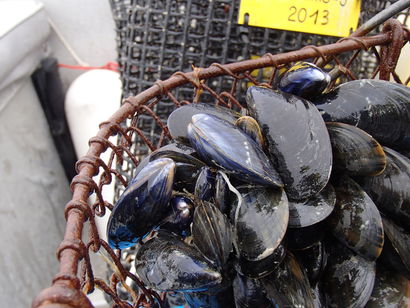Mytilus edulis
Type of resources
Available actions
Topics
Keywords
Contact for the resource
Provided by
Years
Formats
Representation types
status
Scale
-

Concomitantly to the monitoring network of the Blue mussel growth in the Pertuis Charentais sounds, (available soon from SEANOE) high frequency temperature measurements were carried out on a regular basis and on all REMOULA monitoring stations. Temperature were recorded every 15’ on 7 experimental sites from 2010 to 2012. Two environemental conditions were tested, i.e. off shore and intertidal areas. The off-shore sites are located along the long lines mussel growout facilities (Filières Pertuis Breton, Saumonards Filières). Intertidally, temperature sensors were deployed on bouchot type mussel culture (wooden piles) (Roulières, Aiguillon, Marsilly, Boyard-bouchot, Yves). Due to the tidal cycle, the later are emersed on a regular basis – during this period of time, air temperature is recorded. The data set are presented in two ways: raw data (immersion-emersion values) and daily average (only immersed data). The daily average aims to represent the lasting period of mussel activity for further comparison with off shore conditions. For off-shore sites, daily averaged data are presented. For intertidal areas (bouchot type), the average is based upon the two daily high tides. Daily data are recorded in betwwen 2 hours before and after the high tide peak. Figures are presented per campaign and per site. Data temperature are recorded using Tidbit V2 logger (-39°C+75°C) and Sensor EN Optic STOWAWAY TEMP (-39+75°C) ONSET COMPUTER from 2000 to 2009 and NKE STPS30 probes (with and without chlorine system) and YSI 6600 from 2010 to 2012. Data storage is organized using the Quadrige data bank system. Coastal monitoring information are saved in the Coastal monitoring Quadrige information system.
-

On a yearly basis, mussel farming produces around 13 000 metric tons of mussel in the Pertuis Charentais sounds (Pertuis Breton et Pertuis d’Antioche). This represents 23% of the Blue mussel (Mytilus edulis) production along the French Atlantic coastline. Production is characterized in this area by to types of growout systems: the ‘bouchot’ type culture using wooden poles(p) and off-shore longlines(l). Environmental conditions are mainly estuarine. Taking into account those cultural practices, the REMOULA monitoring network has been deployed since 2000 to provide baseline information to better understand the Blue mussel (Aiguillon(p) and Filières Pertuis Breton(l)) or trimester (Roulières(p), Marsilly(p), Yves(p), Boyard-bouchot(p) – completed by the stations Saumonards Filières(l) and Filières Chatellaillon 2(l) (2008 to 2012). Between 2000 and 2005 the mussel batches monitoring lasted 12 months whereas it lasted 15 months from 2006 to 2012. The initial batch of mussel is originating from the spat settlement the previous year and calibrated. On the 8 monitoring stations, calibrated mussel batches were deployed into bags (120 mussels/bag). Biometric data are measured during each monthly survey (30 individuals) and a mortality rate estimated. Additional information is obtained through biochemical analysis (proteins, lipids, carbohydrates) on 3 mussel pools of 10 individuals in 2000, 2001, 2002, 2003 and 2004. Moreover gametogenic data are collected on 15 mussels (2003 and 2004). The data storage is organized using the Quadrige2 system and characterized by individual field campaign. Coastal monitoring data Available parameters : Individual measurement : length, shell weight, dry meat weight. Width and height at the beginning and the campaign end. Average measurement : individual weight (3x10 individuals), Calculated data: Lawrence & Scott indicator, Walne and Mann indicator, meat indicator, mortality rate % Observations : Pinnotheres and Polydora infestations, parasites. Gametic status : identification of 8 maturation stages (0, 1, 2, 3A1, 3A2, 3B, 3C, 3D) according to Lubet (1959) and Suarez (2005) Biochemical data : analytical protocols - Proteins : Lowry et al (1951) modified Razet et al (1976). Lipids : Marsh and Weinstein (1966). Carbohydrates and Glycogen Dubois et al (1956). The shellfish biochemical proximate composition reviewed by Faury, Geairon, Moal, Pouvreau, Razet, Ropert and Soletchnik (2003).
-

Le réseau national d’observation de la moule bleue (MYTILOBS), mis en place en 2012, a pour objectif le suivi de la croissance et de la mortalité des moules destinées à la commercialisation. Le MYTILOBS s’appuie sur l’expérience du réseau régional de suivi de la croissance de la moule bleue dans les pertuis charentais (REMOULA), effectif depuis l’année 2000. La durée du suivi correspond principalement à l’année qui suit l’année de captage : elle intègre ainsi les principales saisons de la vie biologique de la moule, de la maturation hivernale à la croissance printanière, puis à l’engraissement estival et automnal, les deux périodes principales de vente. Le choix des sites de suivi a été déterminé en concertation entre les Laboratoires Environnement Ressource régionaux et la profession. Il s’agit, pour la Bretagne Nord, du site du Vivier-sur-Mer dans le secteur de la baie du Mont-Saint-Michel (moules sur bouchot). Chaque site d’élevage est suivi tout les trois mois. De nombreux paramètres sont mesurés dont les dimensions des moules, leurs poids et la mortalité. Ces données sont mises en parallèles des conditions environnementales telle que la température, la salinité ou encore l'abondance et la richesse des microalgues dont se nourissent les coquillages. Le reseau national Mytilobs est implante dans les principales regions mytilicoles du littoral atlantique : Normandie, Bretagne Nord, Bretagne Sud, Pays de Loire et Poitou-Charentes. Les sites d’Agon (Ouest Cotentin), du Vivier (baie du Mont Saint-Michel), de Pont Mahe (baie de Vilaine), de l’Aiguillon (pertuis Breton), d’Yves (pertuis d’Antioche) representent l'elevage sur bouchot du Nord au Sud. Le site Filiere (pertuis Breton) represente l’elevage sur corde, en pleine eau.
 Catalogue PIGMA
Catalogue PIGMA